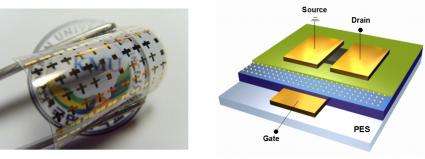July 8, 2010 feature
High reliability of flexible organic transistor memory looks promising for future electronics

(PhysOrg.com) -- With the constant demand for high-performance nonvolatile memory devices, researchers continue to develop better memories - ones with low power consumption, good reliability, and low manufacturing costs. In a recent study, engineers from Korea have demonstrated a flexible memory based on an organic transistor, which they say could be easily and cheaply integrated, along with transistors and logic circuits, into flexible electronic devices.
Engineers Jang-Sik Lee and Soo-Jin Kim from Kookmin University in Seoul, Korea, have published the details of the flexible organic transistor memory in a recent issue of Nano Letters.
“The advancement in this memory device is the improved reliability and stability,” Lee told PhysOrg.com. “Actually, organic electronic devices suffer from the severe degradation in terms of device performance according to the operation time. Here, we demonstrated the improved data retention and endurance capability by optimizing the memory device structures. In addition, the flexible memory devices are found to be very stable in repeated bending cycles, confirming the good mechanical stability.”
As the researchers demonstrated in their study, the memory device can offer controllable threshold voltage for writing and erasing information, storage times of more than a year, and reliability after hundreds of repeated programming/erasing cycles, as well as good flexibility that could endure more than 1,000 repeated bending cycles. Plus, all the fabrication processes could be carried out at low temperatures, enabling lower manufacturing costs.
To design the memory, the researchers took advantage of existing organic transistor devices, which already offer excellent performance. By embedding gold nanoparticles (as charge-trapping elements) and dielectric layers (as charge tunneling and blocking elements) into organic thin-film transistors, the researchers created organic memory devices with similar electrical and mechanical properties as the transistors. The resulting organic transistor-based memory was synthesized on a flexible substrate of about 3 x 3 cm2.
As the researchers explained in more detail, the programming and erasing operations were performed by applying a positive or negative 90-volt pulse for one second to the bottom-gate electrode. For writing information, a negative voltage was applied, which caused charge carriers to tunnel through a 10-nm-thick tunneling layer to reach the gold nanoparticles in the gate dielectric layer. In the charge-trapping layer, each nanoparticle trapped 4-5 holes, which the researchers defined as written states. The written states could be erased by applying a positive voltage that caused the gold nanoparticles to eject the holes. A reading voltage of -8 volts could be applied to measure and read the drain current. The engineers showed that these programming, reading, and erasing operations could be carried out repeatedly with less degradation compared to other memory devices.
“The flexible memory devices that have previously been reported are based on resistive switching memory devices,” Lee said. “In that case, we need additional active components (for example, a diode or transistor) to operate the resistive switching memory elements. The memory devices developed in this study are based on the field-effect transistors, and memory elements are embedded in the gate dielectric layers of organic transistors. So the program/erase operations can be controlled by the transistor operations. This is a great advantage in terms of device scaling and circuit design since the structure is similar to the conventional flash memory devices. So we can use the state-of-the-art flash memory technology to design and fabricate the integrated flexible memory devices.”
Currently, the researchers are working on further enhancing the memory properties of these organic transistor-based memory devices, such as by decreasing the operating voltage. In addition, since most of the device is transparent except for the electrodes, the researchers hope to incorporate transparent electrodes to create a fully transparent, flexible memory device.
“The flexible organic memory devices can be applied to wearable/stretchable/foldable electronic devices,” Lee said. “In addition, there is almost no limit in substrate materials and geometry, so the integration of memory devices onto unconventional substrates is possible. Finally, we think the memory devices can be adopted in see-through displays and head-up displays in the near future.”
• Learn about becoming PhysOrg.com sponsor
More information: Soo-Jin Kim and Jang-Sik Lee. “Flexible Organic Transistor Memory Devices.” Nano Letters. DOI: 10.102/nl1009662 . Contact information: jangsik[at]kookmin.ac.kr
Copyright 2010 PhysOrg.com.
All rights reserved. This material may not be published, broadcast, rewritten or redistributed in whole or part without the express written permission of PhysOrg.com.

















